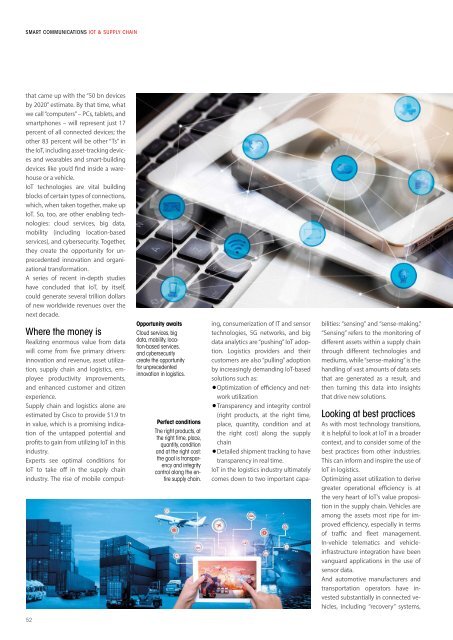Smart Industry 2/2018
Smart Industry 2/2018 - The IoT Business Magazine - powered by Avnet Silica
Smart Industry 2/2018 - The IoT Business Magazine - powered by Avnet Silica
You also want an ePaper? Increase the reach of your titles
YUMPU automatically turns print PDFs into web optimized ePapers that Google loves.
<strong>Smart</strong> Communications IoT & Supply Chain<br />
that came up with the “50 bn devices<br />
by 2020” estimate. By that time, what<br />
we call “computers” – PCs, tablets, and<br />
smartphones – will represent just 17<br />
percent of all connected devices; the<br />
other 83 percent will be other “Ts” in<br />
the IoT, including asset-tracking devices<br />
and wearables and smart-building<br />
devices like you’d find inside a warehouse<br />
or a vehicle.<br />
IoT technologies are vital building<br />
blocks of certain types of connections,<br />
which, when taken together, make up<br />
IoT. So, too, are other enabling technologies:<br />
cloud services, big data,<br />
mobility (including location-based<br />
services), and cybersecurity. Together,<br />
they create the opportunity for unprecedented<br />
innovation and organizational<br />
transformation.<br />
A series of recent in-depth studies<br />
have concluded that IoT, by itself,<br />
could generate several trillion dollars<br />
of new worldwide revenues over the<br />
next decade.<br />
Opportunity awaits<br />
Cloud services, big<br />
data, mobility, location-based<br />
services,<br />
and cybersecurity<br />
create the opportunity<br />
for unprecedented<br />
innovation in logistics.<br />
Perfect conditions<br />
The right products, at<br />
the right time, place,<br />
quantity, condition<br />
and at the right cost:<br />
the goal is transparency<br />
and integrity<br />
control along the entire<br />
supply chain.<br />
Where the money is<br />
Realizing enormous value from data<br />
will come from five primary drivers:<br />
innovation and revenue, asset utilization,<br />
supply chain and logistics, employee<br />
productivity improvements,<br />
and enhanced customer and citizen<br />
experience.<br />
Supply chain and logistics alone are<br />
estimated by Cisco to provide $1.9 tn<br />
in value, which is a promising indication<br />
of the untapped potential and<br />
profits to gain from utilizing IoT in this<br />
industry.<br />
Experts see optimal conditions for<br />
IoT to take off in the supply chain<br />
industry. The rise of mobile computing,<br />
consumerization of IT and sensor<br />
technologies, 5G networks, and big<br />
data analytics are “pushing” IoT adoption.<br />
Logistics providers and their<br />
customers are also “pulling” adoption<br />
by increasingly demanding IoT-based<br />
solutions such as:<br />
• Optimization of efficiency and network<br />
utilization<br />
• Transparency and integrity control<br />
(right products, at the right time,<br />
place, quantity, condition and at<br />
the right cost) along the supply<br />
chain<br />
• Detailed shipment tracking to have<br />
transparency in real time.<br />
IoT in the logistics industry ultimately<br />
comes down to two important capabilities:<br />
“sensing” and “sense-making.”<br />
“Sensing” refers to the monitoring of<br />
different assets within a supply chain<br />
through different technologies and<br />
mediums, while “sense-making” is the<br />
handling of vast amounts of data sets<br />
that are generated as a result, and<br />
then turning this data into insights<br />
that drive new solutions.<br />
Looking at best practices<br />
As with most technology transitions,<br />
it is helpful to look at IoT in a broader<br />
context, and to consider some of the<br />
best practices from other industries.<br />
This can inform and inspire the use of<br />
IoT in logistics.<br />
Optimizing asset utilization to derive<br />
greater operational efficiency is at<br />
the very heart of IoT’s value proposition<br />
in the supply chain. Vehicles are<br />
among the assets most ripe for improved<br />
efficiency, especially in terms<br />
of traffic and fleet management.<br />
In-vehicle telematics and vehicleinfrastructure<br />
integration have been<br />
vanguard applications in the use of<br />
sensor data.<br />
And automotive manufacturers and<br />
transportation operators have invested<br />
substantially in connected vehicles,<br />
including “recovery” systems,<br />
52
















